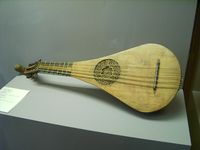Annotation:New New Nothing: Difference between revisions
No edit summary |
m (Text replacement - "garamond, serif" to "sans-serif") |
||
| (One intermediate revision by one other user not shown) | |||
| Line 1: | Line 1: | ||
=='''Back to [[{{BASEPAGENAME}}]]'''== | =='''Back to [[{{BASEPAGENAME}}]]'''== | ||
---- | ---- | ||
<p><font face=" | <p><font face="sans-serif" size="4"> | ||
'''NEW, NEW NOTHING'''. English, Country Dance Tune (cut time). B Flat Major. Standard tuning (fiddle). One part. The melody and country dance directions for a duple minor longways dance ("Longwayes for as many as will") were published in London by John Playford in his '''English Dancing Master''' [http://www.izaak.unh.edu/nhltmd/indexes/dancingmaster/Dance/Play1025.htm] (1651, p. 98). The piece was retained in the long-running series in subsequent editions, through the 8th edition of 1690, after which ceases to appear. Playford also published it in his tutor '''A Booke of New Lessons for the Cithern & Gittern''' (London, 1652, No. 95), where it is a selection for the gittern, a relatively small, quill-plucked, gut strung instrument that came from Europe via Moorish Spain. | '''NEW, NEW NOTHING'''. English, Country Dance Tune (cut time). B Flat Major. Standard tuning (fiddle). One part. The melody and country dance directions for a duple minor longways dance ("Longwayes for as many as will") were published in London by John Playford in his '''English Dancing Master''' [http://www.izaak.unh.edu/nhltmd/indexes/dancingmaster/Dance/Play1025.htm] (1651, p. 98). The piece was retained in the long-running series in subsequent editions, through the 8th edition of 1690, after which ceases to appear. Playford also published it in his tutor '''A Booke of New Lessons for the Cithern & Gittern''' (London, 1652, No. 95), where it is a selection for the gittern, a relatively small, quill-plucked, gut strung instrument that came from Europe via Moorish Spain. | ||
[[File:gittern. | [[File:gittern.JPG|200px|thumb|left|Gittern]] | ||
<br> | <br> | ||
<br> | <br> | ||
</font></p> | </font></p> | ||
<p><font face=" | <p><font face="sans-serif" size="4"> | ||
''Source for notated version'': | ''Source for notated version'': | ||
<br> | <br> | ||
<br> | <br> | ||
</font></p> | </font></p> | ||
<p><font face=" | <p><font face="sans-serif" size="4"> | ||
''Printed sources'': Barlow ('''The Complete Country Dances from Playford's Dancing Master'''), 1985; No. 69. Raven ('''English Country Dance Tunes'''), 1984; p. 47. | ''Printed sources'': Barlow ('''The Complete Country Dances from Playford's Dancing Master'''), 1985; No. 69. Raven ('''English Country Dance Tunes'''), 1984; p. 47. | ||
<br> | <br> | ||
<br> | <br> | ||
</font></p> | </font></p> | ||
<p><font face=" | <p><font face="sans-serif" size="4"> | ||
''Recorded sources'': <font color=teal>Shulamit Kleinerman - "New New Nothing" (2008). | ''Recorded sources'': <font color=teal>Shulamit Kleinerman - "New New Nothing" (2008). | ||
</font> | </font> | ||
Latest revision as of 14:29, 6 May 2019
Back to New New Nothing
NEW, NEW NOTHING. English, Country Dance Tune (cut time). B Flat Major. Standard tuning (fiddle). One part. The melody and country dance directions for a duple minor longways dance ("Longwayes for as many as will") were published in London by John Playford in his English Dancing Master [1] (1651, p. 98). The piece was retained in the long-running series in subsequent editions, through the 8th edition of 1690, after which ceases to appear. Playford also published it in his tutor A Booke of New Lessons for the Cithern & Gittern (London, 1652, No. 95), where it is a selection for the gittern, a relatively small, quill-plucked, gut strung instrument that came from Europe via Moorish Spain.

Source for notated version:
Printed sources: Barlow (The Complete Country Dances from Playford's Dancing Master), 1985; No. 69. Raven (English Country Dance Tunes), 1984; p. 47.
Recorded sources: Shulamit Kleinerman - "New New Nothing" (2008).
